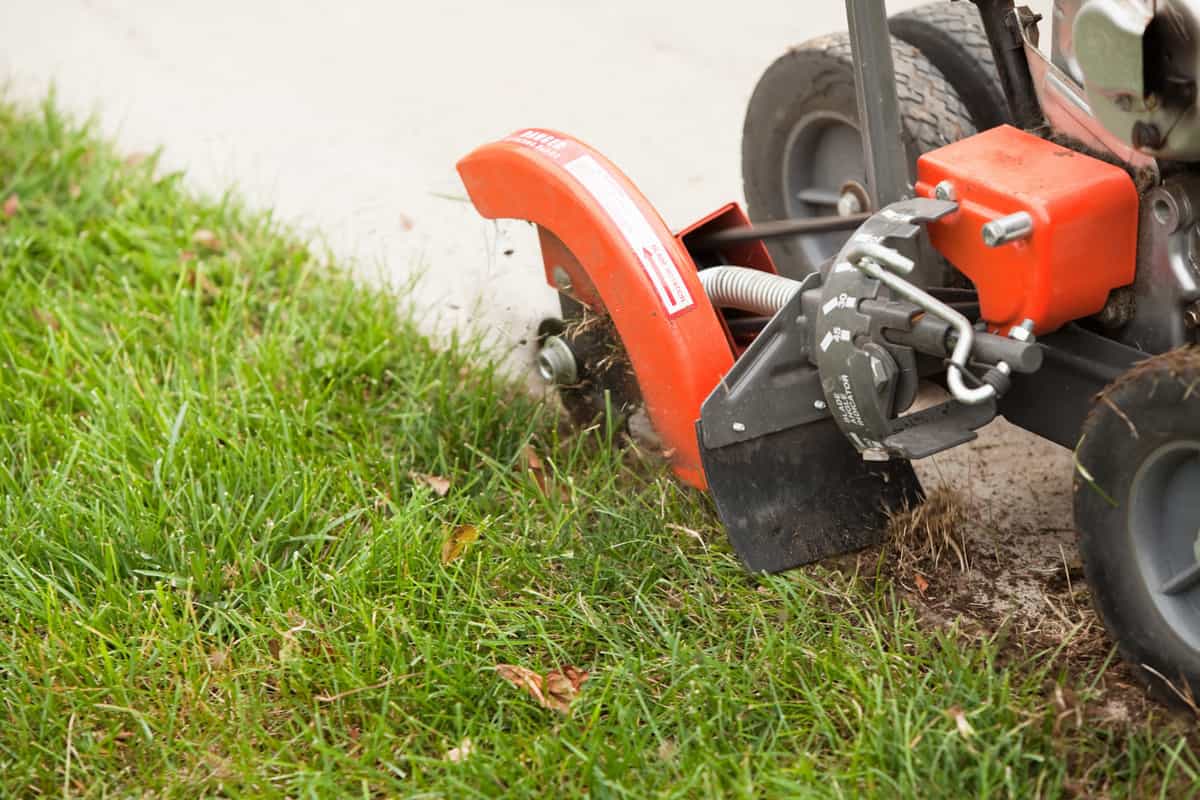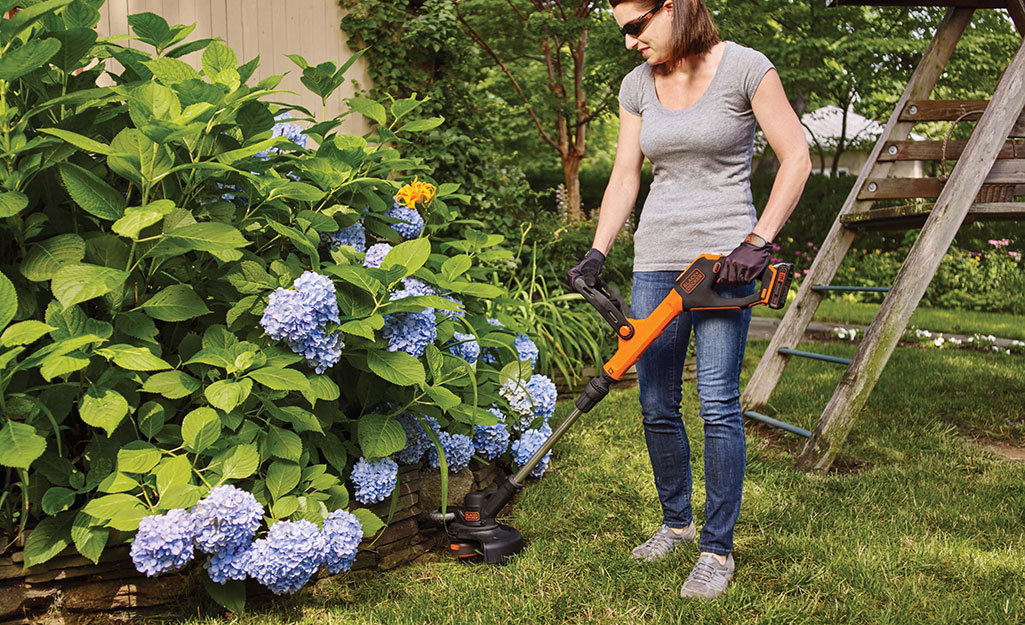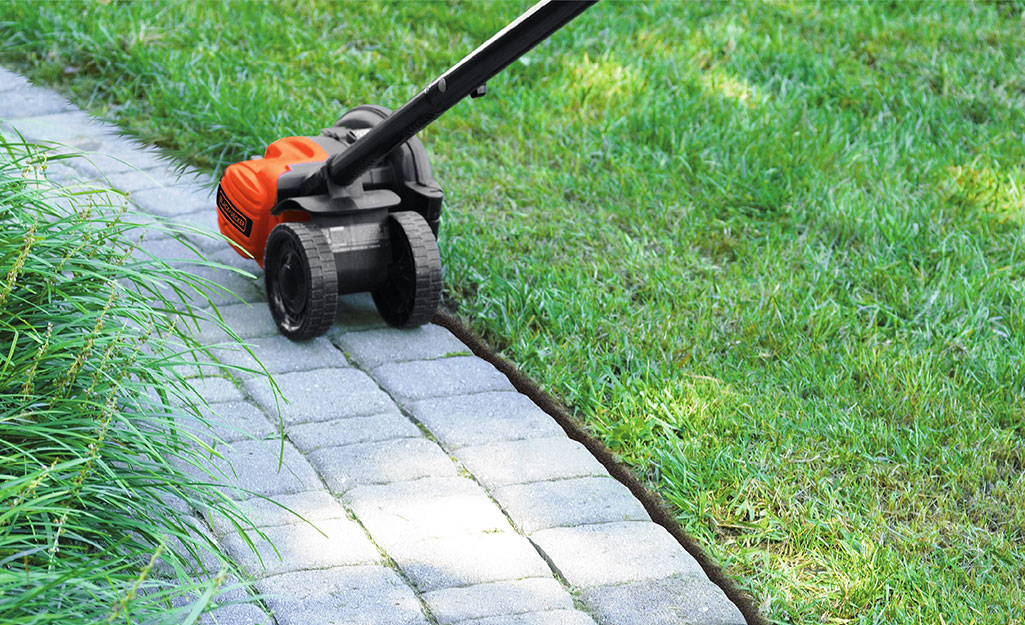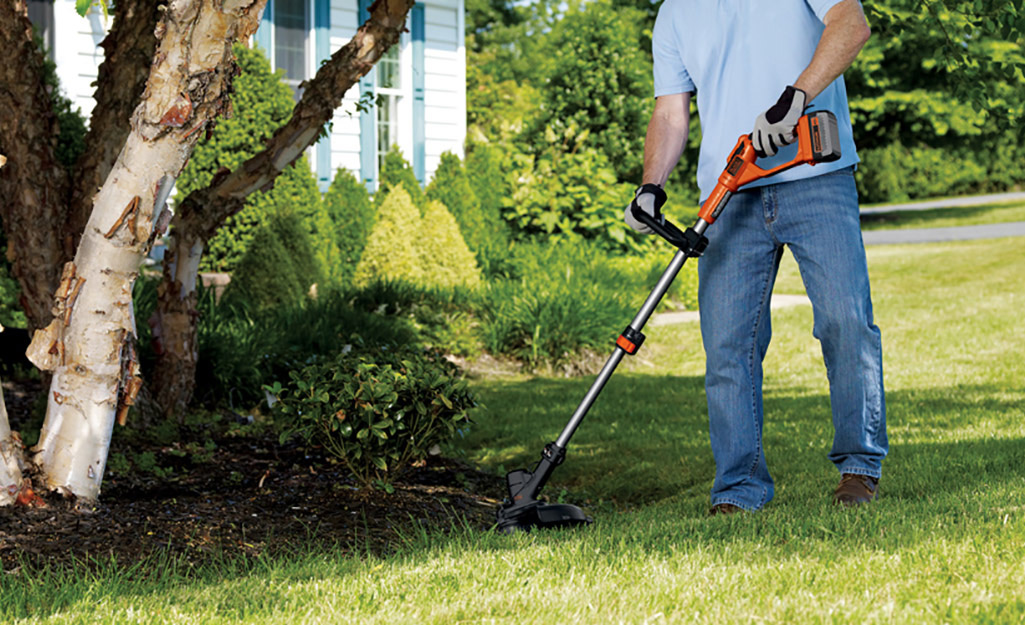A well-kept lawn enhances the curb appeal of any home. Knowing how to edge a lawn will keep your walkways clear of overgrown grass and weeds. You’ll have a more polished look by trimming the edges and sprucing up the border. This guide explains basic lawn care and how to edge a lawn using manual or outdoor power tools such as string trimmers and edgers.
Before you edge your lawn, mow it with a lawn mower set to cut the grass approximately 2 1/2 inches tall.
Make sure not to remove more than the top third of the grass blades each time you mow. If you cut too low, the blades won’t be able to grow and support as many roots as they need to produce a lush, green lawn.
Keeping your lawn looking neat and tidy takes regular maintenance. While mowing is the most common lawn care task, edging is also an important part of achieving a polished, professional look. But how often should you break out the edger and tidy up those borders? This complete guide covers everything you need to know about lawn edging frequency.
What is Lawn Edging?
Edging creates a defined border between your lawn and other surfaces like sidewalks, driveways, and planting beds. It involves cutting a small trench along these edges with a specialized edging tool or string trimmer.
Edging serves both practical and aesthetic purposes:
-
It prevents grass and weeds from spreading into unwanted areas.
-
It gives your lawn a manicured finished look.
-
It makes mowing easier by creating a clean edge to run the mower along
How Often to Edge Lawn
There’s no universal rule for lawn edging frequency. How often you’ll need to edge depends on several factors:
Grass Growth Rate
Fast-growing grasses like St. Augustine will require more frequent edging than slower varieties like Bermuda. During peak growing seasons, you may need to edge every time you mow. When growth slows in winter, edging every third mow may suffice.
Proximity to Hardscapes
Lawns bordering sidewalks, patios and driveways tend to get shaggy faster than lawns enclosed by planting beds. Prioritize edging high-traffic areas first.
Season
Lawn edges degrade fastest in spring when grass growth accelerates. You may need to edge weekly or biweekly during this time. Edging every 2-3 weeks is often adequate in summer and fall. In winter, monthly edging is usually enough.
Fertilization
Fertilizer boosts grass growth, so you’ll likely need to edge more often after applying it. Pay close attention to edges for a few weeks post-fertilization.
Lawn Size
Larger lawns take longer to edge. Break the job into sections and edge a different area each mow.
Personal Preference
Some homeowners don’t mind shaggy edges while others prefer a ruler-straight border. Edge as often as needed to maintain your desired aesthetic.
Signs It’s Time to Edge
Rather than edging on a fixed schedule, it’s best to assess the lawn’s condition before each mow. Watch for these signs that it’s time to break out the edger:
-
Grass creeping into sidewalk cracks or over the driveway
-
Lawn mower wheels rolling on soil rather than grass when mowing perimeter
-
Weeds sprouting in bed areas near the lawn
-
Shaggy, irregular borders
-
Neighboring lawns looking tidier
Edging Tools
You’ve got several options when it comes to edging tools:
-
String trimmer: Effective for edging in curves and tight spaces. Requires a steady hand.
-
Manual edger: Economical option for small yards. No fuel/power required.
-
Walk-behind power edger: Provides crisp, clean edges with little effort. Ideal for larger lawns.
-
Lawn mower edging attachment: Convenient add-on that enables edging and mowing in one pass.
-
Half-moon edging blade: Manual tool that creates a shallow trench along edges. Very inexpensive.
-
electric/gas edger: More power than string trimmers for precise cuts in tough turf.
Edging Technique
Proper technique is key to getting pristine results:
-
Mark edges with spray paint or flour if establishing new borders.
-
Mow lawn first at proper height for grass type. Longer blades edging easier.
-
Hold edger perpendicular to lawn edge, wheels/guard on hardscape side.
-
Work slowly and carefully around obstacles like mailboxes and sprinklers.
-
Apply consistent, gentle pressure rather than forcing the blade.
-
Clean up debris when finished with a blower, broom or mower.
-
Avoid edging in very hot, dry conditions when soil is rock-hard.
When to Edge in Relation to Mowing
It’s best to edge before you mow. Edging first prevents clippings from accumulating along bed edges. It also allows the mower to pick up debris the edger kicks up.
Here’s a simple edging and mowing workflow:
- String trim edges and obstacles mower can’t reach
- Edge along beds, sidewalks and driveways
- Mow lawn
- Blow or sweep debris from beds and hardscapes
Edging Maintenance
To keep edges looking sharp between edgings:
-
Set mower wheels to run along the edging trench rather than on the lawn.
-
Hand trim sporadic overgrowth with shears or a string trimmer.
-
Pull weeds as soon as you spot them to prevent spreading.
-
Redefine edges with edger or string trimmer if they become obscured.
Benefits of Regular Edging
Edging brings several benefits beyond just aesthetics:
-
Enhances curb appeal: Crisp, clean edges make a great first impression.
-
Saves time: Preventing grass and weed overgrowth eliminates laborious manual removal later.
-
Reduces weeds: Edging cuts weed roots and stops seeds spreading into the lawn.
-
Improves mowing: Edges give the mower a definite line to follow.
-
Prevents erosion: Defined edges keep gravel or mulch contained in beds.
-
Boosts lawn health: Reduces competition so grass can thrive right up to the edge.
-
Satisfies guidelines: Homeowners associations often require regular edging.
-
Enhances enjoyment: Makes lawn activities like games and picnics more pleasant.
-
Increases value: Manicured landscaping can boost resale value.
Lawn Edging Tips
Follow these tips for great edging results:
-
Inspect tools pre-use and replace worn blades for clean cuts.
-
Wear protective gear like glasses, gloves and closed-toe shoes when edging.
-
Hydrate lawn and soften soil a day before edging for easier trenching.
-
Follow manufacturer fuel and safety instructions for powered edgers.
-
Sweep or blow clippings immediately to avoid smothering grass and beds.
-
Mulch or compost debris rather than sending it to landfills.
-
Have sprinkler heads and utilities marked if edging in those areas.
-
Edge uphill rather than downhill for better control and traction.
How Often Should You Edge Your Lawn?
Edging frequency depends on many factors, but a good rule of thumb is every 2-3 mowings during peak growth periods, and once monthly in cooler months. Set a reminder on your calendar to inspect lawn edges prior to each mow. Your edging regimen may require adjustment based on grass type, season, lawn size and your own preferences. But staying on top of this important task will keep your lawn looking its best.

Choose Edging & Trimming Tools

Proper landscaping means understanding the difference between edging and trimming. With edging, an actual cut is made in the lawn. This “edge” puts a line between the grass and borders or sidewalks.
Trimming is cutting grass in spaces where your lawn mower can’t reach, such as against a wall or fence. The tools for edging a lawn and the ones for trimming a lawn can be different. Below are several manual and power tools you can use to properly edge or trim a lawn.
String trimmers are available in gas, electric and corded or cordless models. Some come in kits with attachments to tackle different tasks.
- Gas string trimmers are great for larger lawns and can be used when the ground is damp, while electric trimmers are lightweight and more environmentally friendly.
- Cordless string trimmers usually run on rechargeable lithium-ion batteries. This makes them both lightweight and portable. Maintenance is minimal.
A wheeled lawn edger cuts edges quickly and efficiently, up to 90 feet per minute. It’s user-friendly, with fingertip controls and a ratchet-arm with a height adjustment feature.
- A bed edger lets you define and create flower beds in your landscape. Its zero-turn steering makes shaping borders easy.
- Edging shears are ideal for snipping away grass in awkward places such as stepping stones or around garden beds.
Tip: A string trimmer works well for curves while edging shears may be best for garden paths or small patios.

For complicated or curvy projects, consider marking the edging areas with stakes and string. Start at the perimeter and work your way inward. For large, relatively flat areas, try to begin and end at the same point for a more efficient result.
Safety Tip: Make sure to wear gloves to protect your hands and always wear safety glasses. Use ear protection such as plugs when operating power tools.
Using a Lawn Edger

Lawn edgers cut a trench between the grass and hedges or other areas using a very sharp blade. A lawn edger is a tool that you can use to trim the grass on the very edge of a lawn or flowerbed that the lawnmower may not be able to reach. They work really well when figuring out how to edge a sidewalk or keep grass from growing over a walkway.
Tip: Be careful when edging around rocks, mailboxes or other obstacles to avoid damaging the blade.
Should you edge lawns EVERY WEEK?!
FAQ
How often should I edge a lawn?
Use edging shears after each time you mow your lawn. This may be as often as once a week when grass is in full growth.
Is edging a lawn worth it?
Edging also serves a practical purpose. If left unchecked, grass will grow into landscape beds and over the edges of pavement. Edging creates a root barrier that stops grass from invading. And if you keep up with regular edging it will save you time when you’re trimming.
What is the 1 3 rule for lawn?
-
Why it’s important:
- Promotes healthy growth: By only removing a portion of the blade, the grass can continue to photosynthesize and develop a strong root system.
- Reduces stress: Cutting off too much at once can shock the grass, potentially slowing growth or making it more susceptible to disease.
- Minimizes clumping: When grass is cut too short, clippings can become too large, clumping and smothering the grass below.
- Improves aesthetics: A lawn that is mowed frequently and with the one-third rule in mind will tend to be denser, more uniform, and less susceptible to weeds.
- Promotes healthy growth: By only removing a portion of the blade, the grass can continue to photosynthesize and develop a strong root system.
-
How to apply it:
- Determine your ideal mowing height: For most lawns, a height of 2-3 inches is a good starting point.
- Calculate the one-third rule: If you are cutting at 2 inches, you would need to mow when the grass reaches 3 inches (2/3 = 0.666).
- Mow before the one-third rule is exceeded: For a 2-inch cut, mow when the grass reaches 3 inches.
- Adjust mowing height if needed: If you find you need to mow very frequently, consider raising the mowing height to allow for a longer growth period between cuts, while still adhering to the one-third rule.
- Determine your ideal mowing height: For most lawns, a height of 2-3 inches is a good starting point.
-
Example:
- If your ideal mowing height is 2 inches, you should mow when the grass reaches 3 inches.
- If your ideal mowing height is 3 inches, you should mow when the grass reaches 4.5 inches.
- If your ideal mowing height is 2 inches, you should mow when the grass reaches 3 inches.
How often do you have to trim your lawn?
-
Spring:As the weather warms and the grass starts to grow actively, you’ll need to mow more frequently, aiming for every 7-10 days.
-
Summer:During the peak growing season, you’ll likely need to mow more often, perhaps every 4-7 days, depending on the type of grass and weather conditions.
-
Fall:As temperatures cool down and grass growth slows, you can gradually reduce the mowing frequency to every other week.
-
Winter:In Los Angeles, with its mild winters, you may still need to mow occasionally, but the frequency will be significantly reduced.
How do you edge a lawn?
To edge your lawn, you can use a string trimmer or an edger. Either of these garden tools will create a nice and clean cut between your lawn and the surrounding area, such as flower beds and driveways. The benefits of edging your lawn can include the following items:
Do you need to edge a lawn every time you Mow?
You won’t need to edge every time you mow the lawn. Use your edger and trim a clean line as you see the borders growing out. Proper edging technique helps you to cut your lawn-care time after you have edged for the first time during the growing season. Don’t scrape the edger blade against concrete. You’ll ruin the blade.
When should you re-edge your lawn?
For regular upkeep, you should re-edge every border of your lawn in the spring. This can be a big project depending upon the size of your yard, but it’s worth doing. If you do, you’ll simply need to maintain that edge by trimming it through the summer. Most lawn grass wants to spread out.
When should you edging your lawn?
Most lawns only require edging once per year, and the best time to do it is in late June. This avoids the peak growing season of April and May, and it also helps you take advantage of slower growth from July onward. By edging at the right time, the results will last longer and you’ll need less touch-ups.
How often should you Mow Your Lawn?
A few things to keep in mind: How often you’ll need to mow and tidy the edges depends on the time of year, the size of your lawn and how often you fertilize. Start with weekly touch-ups to see how quickly the grass grows and then adjust your schedule accordingly.
How do you care for an edged lawn?
Use edging shears for quick touch-ups between major edging sessions. Water deeply but infrequently to encourage deep root growth. Use a natural herbicide along the freshly-cut edges to prevent weed growth. Fertilize your edged lawns according to their type and season.
